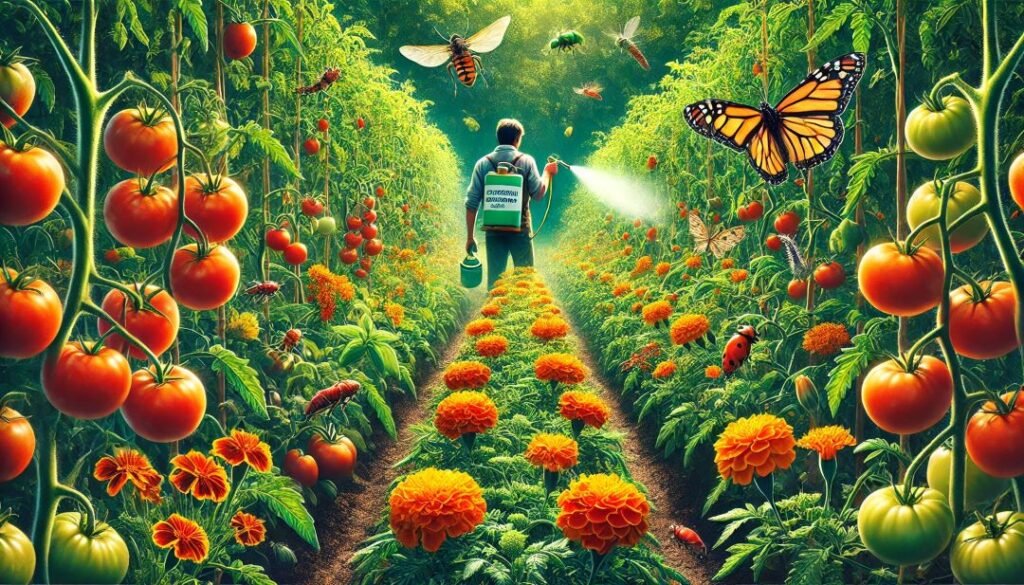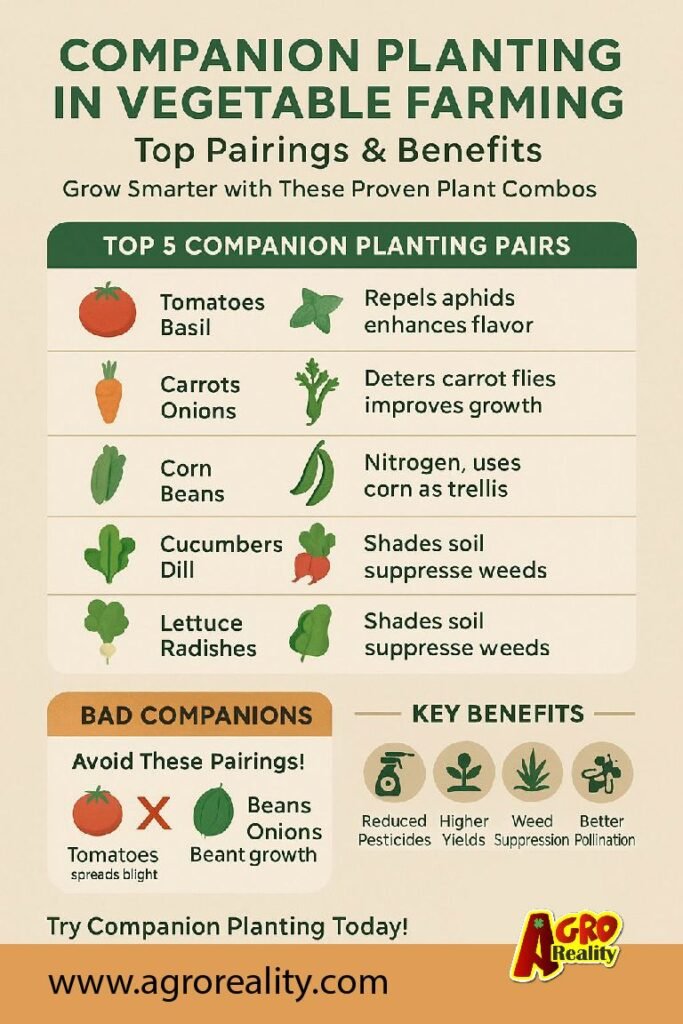
Introduction
The growing interest in chemical-free, sustainable gardening has sparked a revival of time-tested practices like companion planting in vegetable farming. This eco-friendly method involves growing specific plants together to enhance growth, deter pests, and improve soil health. Whether you’re a beginner or a seasoned gardener, companion planting offers a natural way to maximize your garden’s potential without relying on synthetic pesticides or fertilizers. In this guide, you’ll discover practical vegetable pairings, pest control strategies, and soil improvement hacks to transform your garden into a thriving, biodiverse ecosystem. Let’s dive into how companion planting can make your vegetable garden more productive and sustainable, all while keeping things simple and effective.
What is Companion Planting?
Companion planting in vegetable farming is the strategic pairing of plants that benefit each other when grown together. For example, some plants repel pests, while others enrich the soil or provide physical support. This practice has roots in ancient agricultural systems, like the Native American “Three Sisters” method, where corn, beans, and squash were grown together for mutual benefits. Unlike monoculture, which grows a single crop and often depletes soil, companion planting promotes biodiversity and is a cornerstone of permaculture and organic gardening. By mimicking nature’s balance, it creates a healthier, more resilient garden.
How Does Companion Planting Work?
Companion planting leverages natural plant relationships to improve garden health. Here’s how it functions across three key areas:
Natural Pest Control
Certain plants act as natural pest repellents or traps. For instance, marigolds release chemicals that deter nematodes, while basil repels aphids when planted near tomatoes. A study from the University of California, Davis, found that marigolds reduced nematode populations by up to 90% in test plots (UC Davis, 2018). Real-life example: planting basil with tomatoes not only protects against aphids but can also enhance tomato flavor.
Nutrient Sharing and Soil Health
Some plants, like beans and peas, are nitrogen-fixing, meaning they convert atmospheric nitrogen into a form plants can use, enriching the soil. Deep-rooted plants like comfrey or sunflowers improve soil aeration, allowing better water and nutrient uptake. According to the Rodale Institute, intercropping with legumes can increase soil nitrogen levels by 10–20% (Rodale Institute, 2021).
Physical Support and Shade
Tall plants like corn or sunflowers provide shade for shade-loving crops like lettuce or spinach. Vines, such as pole beans or cucumbers, can use corn stalks or sunflowers as natural trellises, saving space and promoting healthy growth. This synergy, seen in the Three Sisters method, maximizes garden efficiency.
Benefits of Companion Planting in Vegetable Farming
Companion planting offers numerous advantages for vegetable farmers:
- Reduced Pesticide Use: Plants like marigolds and garlic naturally deter pests, minimizing the need for chemical interventions.
- Higher Yields: Synergistic pairings, like corn and beans, can boost yields by up to 15%, according to a 2020 study by Iowa State University (Iowa State University, 2020).
- Weed Suppression: Dense plantings, such as lettuce with carrots, shade the soil, reducing weed growth.
- Improved Biodiversity: Diverse plantings attract pollinators like bees, enhancing crop pollination and ecosystem health.
Best Companion Planting Combinations

Here are some proven vegetable pairings to optimize your garden:
Top 10 Vegetable Companion Planting Pairs
| Vegetable | Best Companions | Benefits |
|---|---|---|
| Tomatoes | Basil, Marigold, Carrot | Pest repellent, flavor enhancement |
| Carrots | Onions, Leeks, Tomatoes | Pest deterrent, improved growth |
| Cucumbers | Radishes, Beans, Dill | Beetle deterrent, better pollination |
| Lettuce | Carrots, Radishes, Strawberries | Soil shading, weed suppression |
| Corn | Beans, Squash, Melons | Nitrogen fixation, physical support |
| Beans | Corn, Squash, Spinach | Nitrogen enrichment, space efficiency |
| Squash | Corn, Beans, Nasturtium | Pest repellent, ground cover |
| Onions | Carrots, Lettuce, Chamomile | Pest deterrent, improved flavor |
| Peppers | Basil, Onions, Spinach | Pest protection, soil health |
| Spinach | Strawberries, Peas, Beans | Shade provision, nutrient sharing |
These combinations, rooted in traditional and scientific practices, ensure a healthier, more productive garden.
To know more about organic farming, check out our guide on How to Control Pests Naturally: Eco-Friendly Pest Management Tips
Plants You Should NOT Grow Together (Bad Companions)
Not all plants play well together. Some compete for nutrients or release chemicals (allelopathy) that inhibit growth. For example:
- Tomatoes + Potatoes: Both are susceptible to blight, increasing disease risk.
- Beans + Onions: Onions release compounds that stunt bean growth, reducing yields.
- Cabbage + Strawberries: Cabbage can inhibit strawberry development due to nutrient competition.
A 2019 study from Cornell University highlighted how allelopathic interactions, like those between beans and onions, can reduce yields by up to 25% (Cornell University, 2019).
Scientific Backing & Expert Opinions
Companion planting isn’t just folklore—it’s backed by science. The University of California, Davis, found that marigolds significantly reduce soil nematodes, improving crop health (UC Davis, 2018). The Rodale Institute notes that intercropping legumes with vegetables enhances soil fertility and reduces fertilizer needs (Rodale Institute, 2021). Dr. John Biernbaum, a horticulture expert at Michigan State University, states, “Companion planting mimics natural ecosystems, creating resilient gardens with minimal inputs” (Michigan State University, 2020).
Tools and Tips to Get Started with Companion Planting
Ready to try companion planting in vegetable farming? Here’s how to begin:
- Plan Your Layout: Sketch your garden to pair compatible plants and avoid bad companions.
- Use Companion Planting Apps: Tools like the “Garden Plan Pro” app or printable charts from sites like The Old Farmer’s Almanac simplify planning.
- Try Raised Beds or Intercropping: Raised beds make it easier to control soil conditions and pair plants effectively.
- Recommended Products: Consider organic seed kits from Burpee or soil test kits to optimize planting conditions.
Companion Planting for Different Climates
Companion planting in vegetable farming adapts to various climates:
- Warm Climates (e.g., Southern US): Pair heat-loving crops like tomatoes with basil or marigolds to deter pests in high temperatures.
- Cool Climates (e.g., Canada, UK): Grow lettuce with radishes to maximize cool-season growth and suppress weeds.
- Frost Zones: Check regional planting calendars, like those from USDA Hardiness Zones or the UK’s RHS Planting Calendar, to time your pairings.
FAQs About Companion Planting
- Does companion planting really work?
Yes, studies from institutions like UC Davis show companion planting reduces pests and improves yields by leveraging natural plant synergies (UC Davis, 2018). - Can you do companion planting in raised beds?
Absolutely! Raised beds are ideal for companion planting, as they allow precise plant placement and soil management. - What are the easiest vegetables to grow together?
Tomatoes with basil or carrots with onions are beginner-friendly pairings that offer pest control and growth benefits. - Can companion planting help with tomato hornworms?
Yes, planting marigolds or dill near tomatoes can deter hornworms by attracting beneficial insects like ladybugs. - How do I avoid bad companion plants?
Use a companion planting chart and avoid pairings like tomatoes with potatoes to prevent disease or competition. - Is companion planting suitable for small gardens?
Definitely! It maximizes space and efficiency, making it perfect for small plots or container gardens.
Conclusion
Companion planting in vegetable farming is a natural, sustainable way to boost your garden’s health and productivity. By pairing plants strategically, you can reduce pesticide use, enhance soil fertility, and increase yields—all while supporting biodiversity. Start small by trying pairings like tomatoes with basil or corn with beans this season. Experiment, observe, and share your results in the comments or on social media to inspire others! For more gardening tips, check out our guide to organic pest control or explore The Old Farmer’s Almanac for seasonal advice. Happy planting!